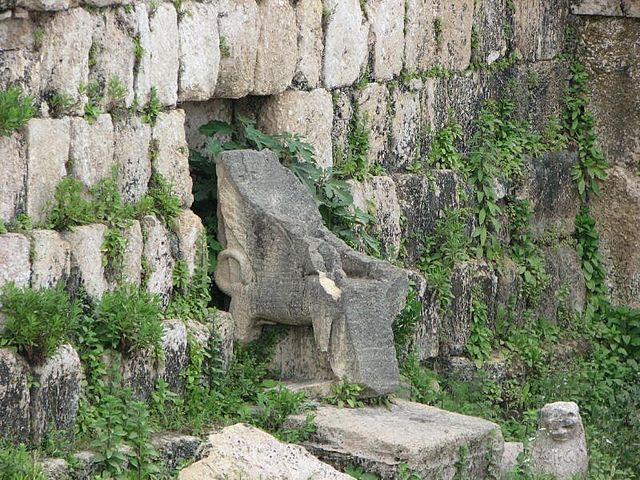Eshmun: Difference between revisions - Wikipedia
 Article Images
Article Images
Content deleted Content added
| (10 intermediate revisions by 8 users not shown) | |||
Line 15: | script_name = Phoencian | script = 𐤀𐤔𐤌𐤍 | gender = | temples = [[Temple of Eshmun]] at Bostan el-Sheikh, Sidon | symbol = Serpent }} }}'''Eshmun''' (or '''Eshmoun''', less accurately '''Esmun''' or '''Esmoun'''; {{lang-phn|𐤀𐤔𐤌𐤍}} ''{{transl|sem|ʾšmn}}''; {{lang-akk|𒅀𒋢𒈬𒉡}} ''Yasumunu'') was a [[Phoenicia]]n god of healing and the [[tutelary deity|tutelary god]] of [[Sidon]].▼ {{Fertile Crescent myth (Levantine)}} {{Middle Eastern deities}} ▲ ==History== Eshmun was known at least from the [[Iron Age]] period at [[Sidon]] and was worshipped also in [[Tyre (Lebanon)|Tyre]], [[Beirut]], [[Cyprus]], [[Sardinia]], and in [[Carthage]] where the site of Eshmun's temple is now occupied by the [[acropolium of Carthage]].{{ According to [[Eusebius of Caesarea]], Phoenician author [[Sanchuniathon]] wrote that [[Sydyk]], 'The Righteous', first fathered seven sons equated with the Greek [[Cabeiri]] or [[Dioscuri]], no mother named, and then afterwards fathered an eighth son by one of the seven Titanides or Artemides. (See [[Kotharat]]). The name ''Eshmun'' appears to mean 'the Eighth'. The Neo-Platonist [[Damascius]] also stated<ref>Damascius, ''Vita Isidori'' 302:</ref> {{ [[Photios I of Constantinople|Photius]] (''Bibliotheca'' Codex 242) summarizes Damascius as saying further that Asclepius of Beirut was a youth who was fond of hunting. He was seen by the goddess Astronoë (thought by many scholars to be a version of [[Astarte]]) who so harassed him with amorous pursuit that in desperation he [[castration|castrated]] himself and died. Astronoë then named the youth ''Paeon'' 'Healer', restored him to life from the warmth of her body, and changed him into a god.{{Sfn|Cassel|1872|p=26}}{{Sfn|Court de Gébelin|1773|pp=67–68}} A trilingual inscription of the 2nd century BCE from Sardinia<ref>''KAI.'' 66</ref> also identifies Eshmun with the Greek [[Asclepius]] and the Latin Aesculapius. [[Pausanias (geographer)|Pausanias]] quotes a Sidonian as saying that the Phoenicians claim [[Apollo]] as the father of Asclepius, as do the Greeks, but unlike them do not make his mother a mortal woman.<ref>Pausanias, 7.23. In Cyprus, Eshmun was syncretized with [[Melqart]],{{sfn|Sauer|2018|p=140}}{{sfn|Greenfield|1995|p=433}} and also in [[Ibiza]], as given by a dedication reciting: "to his lord, Eshmun-Melqart".{{sfn|Ogden|2021|p=470}} Line 37 ⟶ 40: ==Worship== The [[ Also found near the temple was a gold plaque of Eshmun and the goddess [[ == Place names == A village near Beirut named Qabr Shmoun, "Eshmoun's grave," still exists.{{ ==See also== Line 50 ⟶ 53: ==References== {{Reflist}} ==Bibliography== *{{citation|last=Greenfield|first=Jonas Carl|year=1995|title= Solving Riddles and Untying Knots: Biblical, Epigraphic, and Semitic Studies in Honor of Jonas C. Greenfield|url= https://books.google.com/books?id=VLyUd1hau1IC&dq=to+his+lord+eshmun+melqart&pg=PA433|publisher=Eisenbrauns|isbn= 978-0-931464-93-5}}. *{{citation|last=Ogden|first=Daniel|year=2021|title= The Oxford Handbook of Heracles|url= https://books.google.com/books?id=zy0zEAAAQBAJ&dq=to+his+lord+eshmun+melqart+ibiza&pg=PA470|publisher=Oxford University Press|isbn= 9780190650988}}. *{{citation|last=Sauer|first=A.|year=2018|title= The Archaeology of Jordan and Beyond: Essays in Memory of James A. Sauer|url= https://books.google.com/books?id=st6mDwAAQBAJ&dq=to+his+lord+melqart+eshmun&pg=PA140 |publisher=Brill|isbn= 9789004369801}}. *{{Cite book |last=Cassel |first=Paulus |url=https://books.google.com/books? *{{Cite book |last=Court de Gébelin |first=Antoine |url=https://books.google.com/books?id=e-AFv9-HgDQC *{{Cite book |last=Lipiński |first=Edward |url=https://books.google.com/books?id=RKxLnTEqXwIC |title=Dieux et Déesses de l'Univers Phénicien et Punique |date=1995 |publisher=Peeters Publishers |isbn=978-90-6831-690-2 |location=Leuven |pages=154–168 |language=fr |trans-title=Gods and Goddesses of the Phoenician and Punic Universe |oclc=33211400 |author-link=Edward Lipiński (orientalist)}}
{{Authority control}}▼ * ▲{{Middle Eastern mythology}}{{Authority control}} [[Category:Eshmun| ]] [[Category:West Semitic gods]] [[Category:Tutelary [[Category:Health gods]] [[Category:Phoenician mythology]] [[Category:Temple of Eshmun]] [[Category:Melqart]] | |||